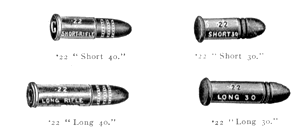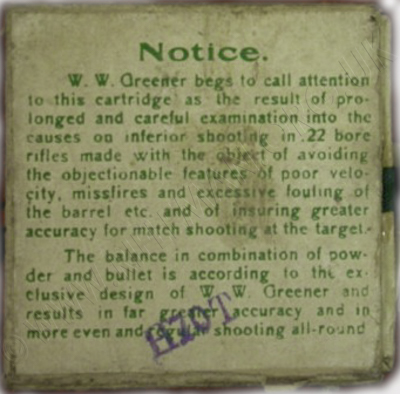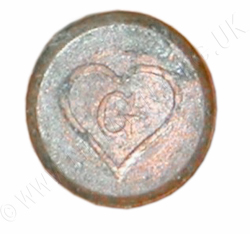W.W. GREENER on AMMUNITION
William Greener wrote of miniature calibre rim-fire ammunition
in his book
"Sharpshooting for War & Defence" - 1914 - from which the
following excerpt is taken.
CHAPTER IV
AMMUNITION
THE British .22 bore rim-fire rifles
are usually chambered to take the " long-rifle " ammunition. There
are five distinct kinds of this ammunition in general use, all varying as regards
external dimensions. The nomenclature employed to distinguish them is not very
satisfactory, they are called " Short," " Long," "
Short-rifle," " Long-rifle," and " Extra-long."
The best results are obtained by using the 40-grain bullet ammunition, which
should always be used in competitions, the chamber and turn of rifling in British
Miniature rifles having been arranged to suit this cartridge. For short ranges
the " short rifle "
G " brand of cartridge will be found satisfactory. This cartridge was introduced
by the author in 1906, when it was found that a short case gave excellent results
up to the 50 yards range, provided a bullet long enough to take the rifling,
and a suitable propellant were used. The turn of the rifling in modern .22 bores
is much too quick to shoot the short 30-grain bullet accurately (most commonly
a pitch of one turn in 16 inches - Ed.) , and with this ammunition one
is apt to get an occasional wide shot, due to " stripping." It may
be employed for the beginner's practice, but after the first few lessons he
would do well to discard it in favour of the " G " Short-rifle "* or " Long-rifle " cartridges.
The constant use of the " Short thirty" ammunition in a rifle chambered
for " Long rifle " cartridges causes erosion of the chamber, destroying
the accuracy of the weapon, and rendering it useless with both Long rifle and
Short cartridges.
The " Extra-long " ammunition should never be used, except in rifles
especially chambered for thisclass of ammunition, in fact, the cartridge cannot
be inserted into ordinary rifles, without effort. The manufacturer is often
asked to build rifles especially to suit the " short " ammunition.
Some makers adopt the plan of merely chambering their rifles, especially for
the " Short " cartridge when required, but very little advantage is
to be obtained by so doing.
Not only are there, as previously stated, five distinct varieties of .22 bore
ammunition, but there are more than a dozen well-known brands, and the variations
between them in external dimensions, quality of metal, and velocity, are considerable.
It is the author's rule to make his rifles a tight fit for the largest brand
of ammunition, and in this way gas escape, and consequent bad shooting, is avoided
when using cartridges of smaller dimensions. One thousandth of an inch variation
in the diameter of the cartridge case or bullet, is sufficient to cause difficulty
in loading or extraction.
It is better to use tightly fitting cartridges so long as they can be pushed
into the chamber by the thumb without too much effort. Other conditions being
equal, such will give better shooting results than cartridges which slip easily
into the chamber. Some cartridges will do this yet owing to the thinness or
softness of the metal, combined with high pressure powder, will expand to such
an extent that they stick in the chamber after firing and require considerable
effort to extract them. It is here that the Martini system is so useful. One
seldom finds a cartridge case, however tight, that cannot be extracted with
the Martini Service rifle, provided reasonable pressure is put in the extractor.
Most rifle clubmen are afraid of the Martini lever ; it was never intended,
as all old soldiers know, to open like a snuff box. The lever should be dropped
smartly using force, if necessary, for there is little likelihood of anything
breaking.
The variations in the thickness of the cartridge metal used also necessitate
a different weight of blow from the striker to suit each kind. The thin metal
of the cases with some cartridges requires a light blow or there is a risk of
piercing the case, and thus causing a " blow back." On the other hand,
if the striker is not long enough or the blow insufficiently hard, one may get
miss-lires with cartridges of harder metal. Here again the manufacturer has
to strike the happy medium.
While on the subject of " Blow-backs " it may be advisable to mention that there is no real danger from these when using the Martini system of breech action. The breech block is broad and extends well beyond the rim of the cartridge affording ample support to its base and directing any escaping gas vertically upwards, or downwards into the action where it escapes in front of the guard. The action work being completely enclosed in the " shoe " or breech body renders gas escape back wards an impossibility.
The illustrations show the actual size of a Martini Service rifle block in conjunction with the base of a •22-bore cartridge, and the direction taken by the gas, in comparison with the small amount of support given to the cartridge by the head of the bolt in a bolt-action rifle which latter is sometimes still further weakened by the fitting of a double extractor.
A frequent cause of missfire with the
Martini action is the collection of fouling on the nose of the striker. This
is forced through the striker hole, and gradually forms a hard ring round the
front of the striker inside the block, where it acts as a buffer and prevents
the full force of the striker being expended upon the cartridge. Another difficulty
easily remedied when one knows the cause is occasioned by small particles of
dirt falling between the extractor and face of the barrel ; this prevents the
extractor going properly into position, jambs the breech block, and is a common
cause of missfire. It is only necessary to clean this part of the action to
make it function properly.
Never mix the brands of ammunition,
or commence to shoot with smokeless ammunition and finish with black or vice
versa. It not infrequently happens that an inexperienced shot borrows a "
round " of another brand from his neighbour to finish his competition ;
such a proceeding is likely to end in disaster. Some factory made tests with
an American smokeless cartridge show that it shoots 'kin. lower at 25 yards
than the latest issue of K.N. (a difference of six minutes of angle), quite
sufficient to give an " outer " if used with a rifle sighted for the
English brand.
Both makes gave excellent shooting, but upon making velocity tests the American
was found to give 300ft. secs. lower muzzle velocity than the standard of 1,050
ft. secs. fixed by the author for the sighting of his rifles.
Gas escape, from whatever cause, is very likely to make bad diagrams and generally
causes the group to " string " vertically due to the irregular velocity.
The defect should be immediately remedied either by changing the brand of ammunition
or by returning the rifle to the maker who can generally correct it in a few
minutes.
One can readily understand that it is a simple matter for a •22-bore cartridge
to leave the factory loaded with cap fulminate and bullet only. Where the fulminate
is sufficiently strong as is the case with the foreign cartridges, the bullet
is blown through the barrel and nothing more serious than a " miss "
is the result, where, however, weaker fulminate is used, the bullet is lodged
in the barrel and in the excitement of shooting the fact that the shot has not
reached the target is unnoticed by the shooter, then when the next shot is fired
both bullets are driven out of the barrel, but in nearly every case the barrel
is " ring bulged." If this bulge is midway down the barrel, no immediate
defect is detected in the shooting, but if at the muzzle erratic shooting is
shown immediately, and in either case a new barrel will eventually be required.
The shooter should always state, when ordering a rifle, what ammunition he proposes
to use in it, or if he has no preference he should ask his rifle maker to advise
him on this point. In this way he will probably save himself much annoyance
and in any case will greatly facilitate the maker's efforts to give him complete
satisfaction.
* "G" Short rifle" refers to the short cartridge with a 40 grain bullet which W.W. Greener apparently expressly commissioned from Rhen-West (the Rhenish Westphalian Explosives Company of Germany - now known as RWS) and sold under his own name. At the time the above notes were written, Rhen-West rimfire ammunition was already well respected, in British miniature rifle shooting circles, for its accuracy. It was marketed as the "R" cartridge, most usually in Long Rifle form.
Below: a box of the very ammunition described.
 ...................
................... 
In the text on the base of the box, William Greener " begs to call attention to this cartridge as the result of prolonged and careful exmination into the causes on inferior shooting in .22 bore rifles made with the object of avoiding the objectional features of poor velocity, missfires and excessive fouling of the barrel etc., and of insuring greater accuracy for match shooting at target.
The balance in combination of powder and bullet is according to the exclusive design of W.W. Greener and results in far greater accuracy and in more even and regular shooting all-round.
Below: a round of the ammunition, and the (not to scale) head stamp.
 ........
........ 
Note that " Sharpshooting for War and Defence" was a pre WWI edition of William Greener's original 173 page publication "Sharp Shooting for Sport and War", first issued in 1900 by R.A. Everett and Co. at the price of 1/- ( one shilling). The later 1914 edition was published in London by Simkin, Marshall, Hamilton, Kent & Co. Ltd., price unchanged.
Return to: TOP of PAGE
See this website's Raison d'être